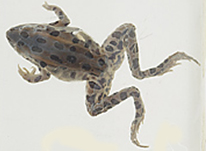8.05 Amphibians: What's Inside?
 Frogs—they're animals that are around us almost all the time, but we often don't take notice. As a vertebrate animal, they have a lot in common with humans; however, they are uniquely different—the three-chambered heart, the small lungs, the webbed feet, large jumping legs, and other special adaptations that make them well suited to the environment in which they live.
Frogs—they're animals that are around us almost all the time, but we often don't take notice. As a vertebrate animal, they have a lot in common with humans; however, they are uniquely different—the three-chambered heart, the small lungs, the webbed feet, large jumping legs, and other special adaptations that make them well suited to the environment in which they live.
 |
In this activity you will:
- describe the basic function of the external and internal structures of a frog
|
Virtual Frog Dissection

It's time to take a break from the Safari Quest. We're headed into the lab. For this activity, you'll be investigating the anatomy (structures) and physiology (functions) of a typical frog. This activity is a virtual dissection.
Follow the steps below and work through the Virtual Frog Dissection.
- Open a Notes Page.
- Copy and paste the following format into your Notes Page and then access the frog dissection.
External Structures and Function
- Click on the external frog and view the external parts of the frog.
- In your Travel Log write down the name of each part you observe and include the functions.
- Also add definitions for the following terms:
- posterior
- anterior
- dorsal
- ventral
Return to the Main Page.
Internal Structures and Function
- Click on the internal frog and click on systems.
- Explore each of the organs in each of the three systems listed.
- Add the organs and their functions to your notes.
Note: The organ names are highlighted. Go to the glossary for their description and function.
- digestive system
- reproductive system
- circulatory
and respiratory system
- Access the Virtual Frog Dissection here: Frog Dissection Lab.
Check Your Understanding
- Finally go to the Test page, link provided below, and practice naming the parts.
- One way to practice naming the parts and knowing the function of the part is to
- Print the page with all the images.
- Number the images
1-15.
- Cut out the images.
- Write the name and function of the structure(s) being indicated by the line(s) pointing to the structure. (If you need some help naming—go back to the dissection to review.)
- Have a parent or friend quiz you.
 Web Resource: Test - Virtual Identification
Web Resource: Test - Virtual Identification
So, how'd you do? Could you name the parts and functions on a real test?
Check your answers here.
Do you like frogs and want to explore them on a different level? The Exploratorium is a great resource. There are articles, videos, and images on lots of concepts related to the frog.
8.05 Frog Dissection
40 points
To complete this activity:
- Go to the assessment area and find assessment 8.05 Frog Dissection.
- Complete the assessment as directed.
Note: Remember to take your Travel Log and Notes Page with you. They may come in handy!
Images © clipart.com 2006 with the exception of the notebook © Paul Anderson 2006.
|




